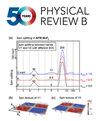基塔耶夫铁磁体中热、自旋和轨道磁振子输运系数的符号变化
IF 3.7
2区 物理与天体物理
Q1 Physics and Astronomy
引用次数: 0
摘要
已知Kitaev和Dzyaloshinskii-Moriya相互作用(DMI)都促进了磁振子霍尔效应的内在贡献,如共线磁体中的热霍尔效应和自旋能效应。以前有报道称,这些横向输运系数的符号变化只出现在Kitaev相互作用存在的情况下,而不出现在DMI存在的情况下,这可以定性地区分铁磁体中两种自旋各向异性相互作用。在此,我们系统地研究了纵向和横向几何中磁振子的热、自旋和轨道输运是如何随着kitaev - dmi比的连续变化而变化的,但磁振子带结构是固定的。我们发现在Kitaev相互作用存在的情况下,一些输运系数具有温度驱动的符号变化,而DMI没有这种变化。特别是,我们发现在纵向轨道输运中有一个符号变化,即磁振子轨道塞贝克效应,而在横向几何中没有,即磁振子轨道能思特效应。这将轨道输运与热和自旋输运区分开来,在热和自旋输运中,我们只发现基塔耶夫相互作用在横向上促进了符号变化,而在纵向几何中没有。2025年由美国物理学会出版本文章由计算机程序翻译,如有差异,请以英文原文为准。
Sign changes in heat, spin, and orbital magnon transport coefficients in Kitaev ferromagnets
Both Kitaev and Dzyaloshinskii-Moriya interactions (DMI) are known to promote intrinsic contributions to the magnon Hall effects such as the thermal Hall and the spin Nernst effects in collinear magnets. Previously, it was reported that a sign change in those transversal transport coefficients only appears in the presence of Kitaev interaction, but not for DMI, which qualitatively distinguishes both kinds of spin-anisotropic interactions in ferromagnets. Herein, we systematically study how the magnon-mediated heat, spin, and orbital transport in longitudinal and transverse geometries evolves with a continuously varying Kitaev-to-DMI ratio, but a fixed magnon band structure. We show that several transport coefficients feature temperature-driven sign changes in the presence of Kitaev interaction, which are absent for DMI. In particular, we find a sign change in longitudinal orbital transport, the magnon orbital Seebeck effect, which is absent in the transverse geometry, the magnon orbital Nernst effect. This sets the orbital transport apart from the heat and spin transport, where we only find sign changes promoted by the Kitaev interaction in transverse, but not in the longitudinal geometry. Published by the American Physical Society 2025
求助全文
通过发布文献求助,成功后即可免费获取论文全文。
去求助
来源期刊

Physical Review B
物理-物理:凝聚态物理
CiteScore
6.70
自引率
32.40%
发文量
0
审稿时长
3.0 months
期刊介绍:
Physical Review B (PRB) is the world’s largest dedicated physics journal, publishing approximately 100 new, high-quality papers each week. The most highly cited journal in condensed matter physics, PRB provides outstanding depth and breadth of coverage, combined with unrivaled context and background for ongoing research by scientists worldwide.
PRB covers the full range of condensed matter, materials physics, and related subfields, including:
-Structure and phase transitions
-Ferroelectrics and multiferroics
-Disordered systems and alloys
-Magnetism
-Superconductivity
-Electronic structure, photonics, and metamaterials
-Semiconductors and mesoscopic systems
-Surfaces, nanoscience, and two-dimensional materials
-Topological states of matter
 求助内容:
求助内容: 应助结果提醒方式:
应助结果提醒方式:


